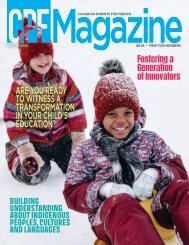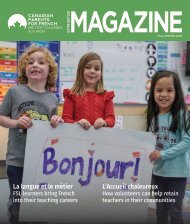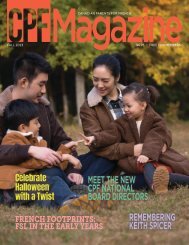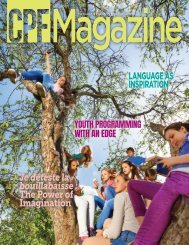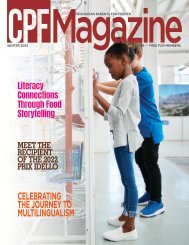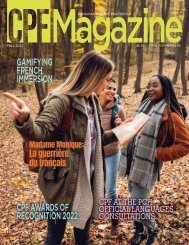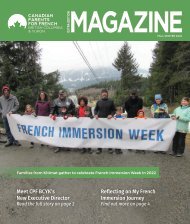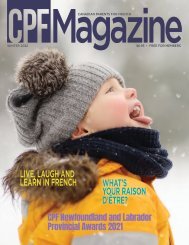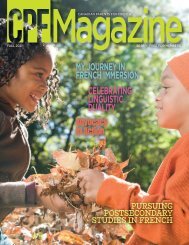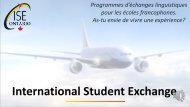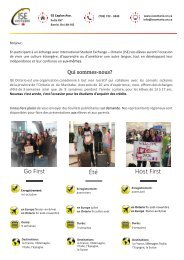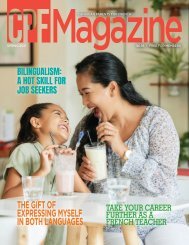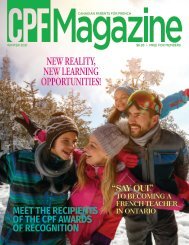CPF Magazine Winter 2020 Issue
A national network of volunteers, parents and stakeholders who value French as an integral part of Canada. CPF Magazine is dedicated to the promotion and creation of French-second-language learning opportunities for young Canadians.
A national network of volunteers, parents and stakeholders who value French as an integral part of Canada. CPF Magazine is dedicated to the promotion and creation of French-second-language learning opportunities for young Canadians.
Create successful ePaper yourself
Turn your PDF publications into a flip-book with our unique Google optimized e-Paper software.
WINTER<strong>2020</strong><br />
<strong>Magazine</strong><br />
$6.95 • FREE FOR MEMBERS<br />
CANADIAN PARENTS FOR FRENCH<br />
HOW TO ACHIEVE<br />
TOTAL IMMERSION<br />
IN FRENCH WITHOUT<br />
LEAVING YOUR HOUSE<br />
Francophone<br />
or Francophile?<br />
PARENTS AS<br />
MULTILINGUAL<br />
EXPERTS
Attention French<br />
Teachers!<br />
Come join our dynamic team today!<br />
Check us out online at www.rcdsb.on.ca or see our current vacancies at<br />
www.applytoeducation.com
<strong>Magazine</strong><br />
CANADIAN PARENTS FOR FRENCH<br />
WINTER <strong>2020</strong><br />
www.cpf.ca<br />
EDITORIAL COMMITTEE<br />
Michael Tryon, Nicole Thibault,<br />
Towela Okwudire, Denise Massie,<br />
Lucie Newson, Marcos Salaiza<br />
CONTRIBUTORS<br />
Catherine Buchanan, Karen Pozniak,<br />
and other authors and organizations,<br />
as noted in their articles.<br />
EDITORIAL MANAGER<br />
Marcos Salaiza<br />
GRAPHIC DESIGN<br />
Stripe Graphics Ltd.<br />
PRINTING<br />
Trico Evolution<br />
SUBMISSIONS<br />
Canadian Parents for French<br />
1104 - 170 Laurier Ave. W.<br />
Ottawa, ON K1P 5V5<br />
(613) 235-1481, www.cpf.ca<br />
Advertising: Cathy Stone<br />
Canadian Parents for French<br />
Email: advertise@cpf.ca<br />
<strong>CPF</strong> <strong>Magazine</strong> is published three times per<br />
year for members of Canadian Parents for<br />
French. Our readership includes parents<br />
of students learning French as a second<br />
language, French language teachers,<br />
school board or district staff, and provincial,<br />
territorial and federal government staff<br />
responsible for official languages education.<br />
CHANGE OF ADDRESS<br />
To signal a change of address,<br />
contact Canadian Parents for French<br />
at (613) 235-1481, or email:<br />
cpf.magazine@cpf.ca<br />
Editorial material contained in this<br />
publication may not be reproduced<br />
without permission.<br />
Publications Mail Agreement No. 40063218<br />
Return undeliverable mail to Canadian<br />
Parents for French at the address above.<br />
To become an online subscriber, email<br />
cpf.magazine@cpf.ca. For an online version<br />
of this issue, visit www.cpf.ca.<br />
WINTER <strong>2020</strong><br />
Table of Contents<br />
FEATURES<br />
3 What Are Immersion Students?<br />
Francophone, Francophile or “In-between”?<br />
7 Parents as Multilingual Experts<br />
10 Celebrating 40 Years of Canadian Parents<br />
for French Saskatchewan<br />
16 5 Ways to Achieve Total Immersion in a<br />
Language Without Leaving Your House<br />
REGULAR ARTICLES<br />
2 PRESIDENT’S MESSAGE<br />
5 <strong>CPF</strong> TECH & MEDIA<br />
Visit Museums from the Comfort of Home – In French!<br />
6 <strong>CPF</strong> RESEARCH<br />
Summary of the State of FSL Education in Canada<br />
2019 Report – Focus on FSL Programs<br />
12 <strong>CPF</strong> EVENTS<br />
Officially 50! A Conference Marking 50 Years of<br />
Linguistic Duality and Education in Canada<br />
18 <strong>CPF</strong> RESOURCES<br />
My Experience with Encounters with Canada<br />
20 KEY <strong>CPF</strong> CONTACTS ACROSS CANADA<br />
This issue of <strong>CPF</strong> <strong>Magazine</strong> is printed<br />
on 70lb Endurance Silk, using vegetable<br />
based inks. The paper is FSC certified by the<br />
Forest Stewardship Council® (FSC®), meaning<br />
it comes from well-managed forests and<br />
known sources, ensuring local communities<br />
benefit and sensitive areas are protected.<br />
Canadian Parents for French is a nationwide, research-informed, volunteer organization<br />
that promotes and creates opportunities to learn and use French for all those who<br />
call Canada home.
PRESIDENT’S MESSAGE<br />
A<br />
cross the country, we are in the midst<br />
of winter. Many of our regions are<br />
experiencing unusual weather<br />
patterns. Unless we are avid sports enthusiasts,<br />
most of us prefer to cocoon inside our homes<br />
with a favourite beverage and a good book.<br />
May I suggest that you consider enjoying the<br />
latest issue of <strong>CPF</strong> <strong>Magazine</strong>? It is full of articles<br />
that will inform you, perhaps have you thinking<br />
a little differently, or taking up a challenge with<br />
respect to FSL education and activities.<br />
Last year was an exciting one for Canadian<br />
Parents for French: <strong>CPF</strong> Saskatchewan celebrated<br />
its 40th anniversary; many of our <strong>CPF</strong> members<br />
were able to attend the Officially 50 Conference,<br />
celebrating the 50th anniversary of the Official<br />
Languages Act; our Branches and Chapters<br />
continued to hold exciting events for students<br />
and their families, they advocated for more<br />
and better programs to serve the needs of<br />
those wanting to learn and use French; a <strong>CPF</strong><br />
Leadership Networking Event was held in<br />
October where we learned about governance<br />
issues that will make us a stronger organization;<br />
the latest report on the State of FSL was<br />
launched at that event, it was wonderful to see<br />
so many people willing and able to share their<br />
experiences with other like-minded individuals.<br />
Whenever I meet <strong>CPF</strong>ers from across the<br />
country, I am struck by their enthusiasm and<br />
willingness to volunteer; attending meetings,<br />
offering programs for students and advocating<br />
on their behalf. I am grateful for the many<br />
hours those volunteers share and spend on<br />
behalf of our organization. If you don’t know<br />
how else you could become involved in more<br />
initiatives, speak to your Branch office or<br />
your local Chapter. They will be happy to<br />
hear from you! n<br />
Nancy McKeraghan,<br />
<strong>CPF</strong> National President<br />
DON’T MISS THE BEST SUMMER<br />
OF YOUR LIFE!<br />
FRENCH IMMERSION SUMMER CAMP<br />
IN QUEBEC CITY<br />
FROM JULY 5 th TO AUGUST 7 th <strong>2020</strong><br />
Université d’Ottawa | University of Ottawa<br />
FRENCH IMMERSION<br />
at uOttawa<br />
► No minimum level of<br />
French required<br />
► French lessons each<br />
morning of the week<br />
► Housing in residence:<br />
single rooms<br />
► Many activities, games,<br />
pedagogical visits and<br />
excursions<br />
► More than 400 students<br />
from all around the world<br />
You are between 14 and<br />
17 years old, have fun with<br />
us this summer learning<br />
French and discovering a<br />
new culture!<br />
A unique opportunity<br />
with unparalleled support!<br />
• French immersion available in 86 undergraduate programs<br />
• Open to core, extended and French immersion students<br />
• Special courses to make the transition to bilingual<br />
university studies<br />
• An extra $1,000 per year for studying bilingually<br />
• An authentic bilingual environment in Canada’s capital<br />
immersion@uOttawa.ca<br />
www.immersion.uOttawa.ca<br />
2 <strong>CPF</strong> MAGAZINE WINTER <strong>2020</strong><br />
CONTACT US:<br />
international@collegegarnier.qc.ca<br />
+1 418 681-0107 ext. 305<br />
garnier-international.com
What Are Immersion Students?<br />
Francophone, Francophile or “In-between”?1<br />
BY CATHERINE ELENA BUCHANAN OLBI ASSOCIATE DIRECTOR AND FRENCH LANGUAGE PROFESSOR<br />
In 2017, the Régime d’immersion en<br />
français 2 of the University of Ottawa<br />
celebrated its 10th anniversary,<br />
at which the Official Languages and<br />
Bilingualism Institute (OLBI) organized<br />
a symposium. All stakeholders were<br />
present – professors, researchers,<br />
politicians, administrators and students<br />
– and a roundtable was organized where<br />
four immersion students spoke about the<br />
shaping and reshaping of their linguistic<br />
identity. The discussion touched on the<br />
confusion that often surrounds certain<br />
key concepts linked to the identity of<br />
learners of French as a second language<br />
(FSL), not only for students but also for<br />
their parents.<br />
How does your child self-identify?<br />
Does she see herself as an anglophone<br />
learning French? Does he consider himself<br />
to be a francophone, a francophile, or<br />
perhaps an “in-between”? What about<br />
the perception of others? The good news<br />
is that concepts of identity are everchanging.<br />
Your child will constantly move<br />
between languages and cultures and be<br />
the richer for it. The bad news is that<br />
they may carry strong feelings about this<br />
linguistic branding.<br />
Francophone<br />
When the etymology of the prefix franco<br />
is analyzed, it is clear that it indicates<br />
either French ancestry or the use of<br />
the French language, often in a specific<br />
region. The suffix phone, which comes<br />
from the Greek phôné, means voice or<br />
sound (Le Petit Robert, 2003). Le Petit<br />
Robert, a dictionary from France, defines<br />
a francophone as a person who, in certain<br />
circumstances, usually speaks French as<br />
either a first or second language (Le Petit<br />
Robert, p. 1125, 2006). This would include<br />
all Canadian FSL speakers, regardless of<br />
their school programs. According to the<br />
Multidictionnaire from Quebec, where<br />
language is a major political issue, a<br />
francophone is someone “whose mother<br />
tongue or language of use is French:<br />
there are more than five million<br />
francophones in Quebec” (p. 663, 2003).<br />
This would exclude most FSL learners.<br />
Finally, from a more official perspective,<br />
Statistics Canada (2010) summarizes the<br />
situation well:<br />
There is no established definition<br />
of Francophone. For historical<br />
reasons, Statistics Canada has<br />
generally used the criterion of<br />
mother tongue, that is, the first<br />
language learned at home in<br />
childhood and still understood<br />
at the time of the census.<br />
Accessed August 23, 2018 at<br />
www150.statcan.gc.ca/n1/pub/<br />
89-642-x/2010001/article/<br />
section1-eng.htm<br />
Francophile<br />
As a result, FSL learners are sometimes<br />
labeled Francophiles, which also causes<br />
confusion. Le Petit Robert defines a<br />
Francophile as someone who “loves<br />
France and the French, supports French<br />
politics "(p. 1124). The Multidictionnaire<br />
broadens the definition to include the<br />
love of francophones. Some academic<br />
institutions have taken it to include FSL<br />
learners. At the University of Ottawa,<br />
a Francophile is defined as someone<br />
who comes from the English-speaking<br />
community, but enjoys both French<br />
culture and language (Knoerr, 2016, p.50).<br />
This entanglement of francophonefrancophile<br />
affects not only FSL learners,<br />
but also those who teach French. For<br />
example, a Franco-Ontarian professor,<br />
who is an established researcher in the<br />
<strong>CPF</strong> MAGAZINE WINTER <strong>2020</strong> 3
field of language policy, tells how her own<br />
identity was shaken when she was told,<br />
in a conference setting:<br />
“Madame, you certainly don't expect<br />
us to consider you francophone.<br />
Francophile, yes, but you<br />
are not francophone.”<br />
In her view, in a franco-dominant<br />
context, I had no right to call<br />
myself francophone. 3<br />
(Lamoureux, 2013, p. 124)<br />
This example demonstrates the<br />
confusion inherent to these terms. The<br />
professor, born and raised in a French<br />
environment, is a true defender of<br />
her community’s rights. Some people,<br />
however, dismiss her roots and identify<br />
her as a francophile since her French is<br />
not “good enough”. What does this mean<br />
to FSL learners?<br />
"In-between"<br />
Immersion students can be defined as<br />
being “in-between” two languages . Roy<br />
(2010) and Lamoureux (2016) see them<br />
as both anglophone and francophone.<br />
However, FSL learners have a hard<br />
time seeing themselves as bilingual; it<br />
seems to be an inaccessible goal. Clearly<br />
they cannot be solely anglophone or<br />
francophone, so they are perceived as<br />
anglophones learning French (Roy, 2010).<br />
They inhabit "an in-between identity to<br />
which are attached cultural values specific<br />
to that space". (Lamoureux, 2016 p.549).<br />
They are at a crossroads.<br />
Identity<br />
These three terms – francophone,<br />
francophile and “in-between” – lead us<br />
to the dual nature of identity. Fortunately<br />
or not, one’s identity is not fixed. It is<br />
formed and reformed along with one’s<br />
environment. Identity is constructed at<br />
school, through encounters with others,<br />
and through learning, collaborating and<br />
playing (Lamoureux & Cotnam, 2012).<br />
This process continues in university and<br />
throughout life. Moreover, the concept<br />
of identity is twofold: however we may<br />
define ourselves, others may define us<br />
differently (Brosseau, 2018).<br />
Language proficiency also affects<br />
immersion learners’ identity (Séror and<br />
Weinberg, 2015). When we speak a second<br />
language, native speakers judge us and<br />
decide whether or not we are legitimate<br />
members of their community, adding to<br />
the complexity of the identity problem.<br />
The round table<br />
At the round table on linguistic identity,<br />
all of the concepts discussed in this article<br />
surfaced repeatedly in the comments of<br />
the four participants. They spoke of their<br />
immersive experiences and how their<br />
identity had evolved through school, work<br />
and social encounters. The question was<br />
put to them: How do you define yourself<br />
linguistically? The overwhelming response<br />
was that they strongly rejected all<br />
labelling. Labels carry connotations, and<br />
even those given with the best intentions<br />
can actually have the adverse effect of<br />
creating distance, or worse, exclusion,<br />
from the French-speaking community.<br />
It appears that the terms francophone<br />
and francophile carry different meanings<br />
depending on who assigns them or<br />
receives them.<br />
All participants mentioned tensions<br />
surrounding their own linguistic identity<br />
and their relationship to French. Through<br />
family and school, they took advantage of<br />
formal and informal learning opportunities<br />
that gave them access to the Frenchspeaking<br />
world. Over time, they gained<br />
self-confidence. Their experience as<br />
immersion students made them aware<br />
that their identity had been transformed<br />
and that they were ready to engage with<br />
francophones. These participants now say<br />
that they consider French as part of their<br />
identity, in an inextricable way, beyond the<br />
labels of francophone or francophile. One<br />
of them said:<br />
[RIF] gave me the confidence and<br />
tenacity to keep trying. I can draw a<br />
very straight although wiggly line from<br />
the immersion program to my job right<br />
now. I had a microcosm of that in<br />
the immersion program or through the<br />
immersion program, and that has had<br />
a big influence on me. I’m now neither<br />
francophone nor anglophone; I am me.<br />
You might ask how I, as a French<br />
professor, would define FSL learners.<br />
My answer is that I don’t really know.<br />
All of these terms are labels; some have<br />
political weight and can ignite fierce<br />
reactions. FSL learners should just be<br />
proud of the fact that they know another<br />
language. It’s a gift.<br />
When we learn a language, we<br />
take on a new identity. We appropriate<br />
its sounds and its culture and learn<br />
something of the values and norms it<br />
conveys. The round table participants<br />
showed how integral French can be to<br />
the identity of FSL learners. Whether<br />
francophone or francophile, it is up<br />
to lovers of the language to adopt all<br />
learners of French and to embrace all<br />
those who identify with its culture.<br />
This is in keeping with the vision of<br />
Tahar Ben Jelloun, a French-language<br />
Moroccan writer, who speaks eloquently<br />
of the richness of knowing multiple<br />
languages:<br />
C'est mieux qu'un simple mélange ;<br />
c'est du métissage, comme deux<br />
tissus, deux couleurs qui composent<br />
une étreinte d'un amour infini.<br />
(It's better than a simple concoction;<br />
it's a blending of two fabrics, two<br />
colours in a embrace of infinite love).<br />
(Le Monde diplomatique,<br />
2003, p. 20). n<br />
To see the complete list<br />
of references, please<br />
visit cpf.ca<br />
1. To read more on the subject: Buchanan, C. E. (2018) (Re)Shaping Identities : The impact of higher education immersion on students’<br />
sense of identity. In Knoerr, H., Weinberg, A. & Buchanan, C. E. Enjeux actuels de l'immersion universitaire / Current <strong>Issue</strong>s in University<br />
Immersion. (153-174). Montréal : Marquis<br />
2. French Immersion Stream<br />
3. « Madame, mais vous ne vous attendez certainement pas à ce qu’on vous considère Francophone. Francophile, oui, mais vous n’êtes<br />
pas Francophone ». À ses yeux, dans un contexte franco-dominant, je n’avais pas le droit de me dire Francophone.<br />
4 <strong>CPF</strong> MAGAZINE WINTER <strong>2020</strong>
<strong>CPF</strong> TECH & MEDIA<br />
>in French!<br />
For those winter days when it’s hard to go out or simply when you want to stay cozy<br />
at home, many Canadian museums offer virtual tours in both English and French!<br />
Not only are these museums fun and interesting, they provide a great resource to<br />
experience French outside of the classroom, right at your fingertips.<br />
Royal Ontario Museum – Toronto, ON<br />
Canada’s largest museum and home to a collection of more than 13 million artworks,<br />
cultural objects, and natural history specimens. You can take a virtual tour through<br />
‘Google Art Project’ which lets you explore the different exhibition spaces and also offers<br />
online exhibitions. While most of the museum tour is in English, the museum’s website<br />
is fully bilingual and provides explanations in French about the current exhibits and galleries.<br />
www.rom.on.ca/en/exhibitions-galleries/exhibitions/online-exhibits<br />
Canadian Museum of History – Canadian History Hall /<br />
Salle de l’histoire canadienne – Gatineau, QC<br />
The Canadian Museum of History is Canada’s most visited museum and one of its oldest<br />
public institutions. The museum has 25,000 square metres of display space that highlight<br />
the country’s history and of mankind. Through their virtual gallery you can explore in both<br />
French and English the “Canadian History Hall” which opened in 2017 for Canada’s 150th<br />
anniversary. It encompasses 3 galleries dedicated to Canadian history from its early days<br />
to our modern era. www.museedelhistoire.ca/salle-de-lhistoire/visite-virtuelle<br />
Canadian Museum of War – Ottawa, ON<br />
Canada’s museum of military history in the nation’s capital has exhibitions that cover all<br />
of Canada’s involvement in historic military past, and the role it has played in the world.<br />
Besides having permanent galleries, the museum has special exhibitions throughout the<br />
year, many of which are available online! Head over to this virtual tour whether you<br />
want to learn about Canada’s role in the First World War, its naval history, or simply<br />
the chronology of the country’s military history. Fully bilingual.<br />
www.museedelaguerre.ca/expositions/expositions-en-ligne<br />
Virtual Museum of Canada<br />
The Virtual Museum of Canada is a federally funded program managed by the<br />
Canadian Museum of History that is working to build digital capacity in Canadian<br />
museums and lets Canadians access different exhibitions across the country. This<br />
museum has a great selection of exhibitions ranging from arts, history, nature, science,<br />
among many more topics from different cities around the country. Fully bilingual.<br />
www.museevirtuel.ca/virtual-exhibits/type/expositions-virtuelles<br />
<strong>CPF</strong> MAGAZINE WINTER <strong>2020</strong> 5
<strong>CPF</strong> RESEARCH<br />
SUMMARY OF<br />
The State of FSL Education<br />
in Canada 2019 Report<br />
In October, <strong>CPF</strong> launched the 2019<br />
edition of its research series “The State<br />
of French Second Language Education<br />
in Canada Focus on FSL Programs”, this<br />
was the third installment of the series<br />
after Focus on FSL students (2017) and<br />
Focus on FSL teachers (2018).<br />
The 2019 edition offers a review<br />
of current FSL education literature<br />
conducted by Stephanie Arnott and<br />
Mimi Masson to identify key research<br />
findings by FSL program and provide<br />
insight into pedagogical hallmarks and<br />
potential lessons that can be learned<br />
from studies across different programs.<br />
Key themes that are described include<br />
literacy instruction, grammar instruction<br />
and inclusive practices. Particular<br />
attention was paid to research in core<br />
French contexts, especially areas where<br />
innovations could inform other FSL<br />
programs, such as French immersion. Two<br />
such areas were: arts-based instruction<br />
and instructional experimentation.<br />
Given that the three FSL programs<br />
with the most amount of students are<br />
core French, intensive French, and<br />
French immersion, the report also<br />
includes articles for each of them in<br />
an ‘interview’ format with researchers<br />
from each program:<br />
n Focus on Core French:<br />
Sharon Lapkin and Stephanie Arnott<br />
underline the need to infuse new life<br />
into core French programs, calling for a<br />
‘revolution’ entailing a reconsideration<br />
of student motivation and alternative<br />
distributions of instructional time for<br />
this FSL program that serves most<br />
Canadian students.<br />
n Focus on intensive French:<br />
Wendy Carr reviews the history and<br />
successes of intensive French programs,<br />
emphasizing how a literacy-based<br />
approach along with some intensity<br />
of instructional time can provide a<br />
solid foundation for bilingualism.<br />
6 <strong>CPF</strong> MAGAZINE WINTER <strong>2020</strong><br />
BY <strong>CPF</strong> NATIONAL RESEARCH SUPPORT WORKING GROUP<br />
n Focus on French immersion:<br />
Roy Lyster highlights findings from an<br />
extensive review of French immersion<br />
programs, pointing out strengths and<br />
areas for improvement identified<br />
through research. He summarizes<br />
his ‘counterbalanced approach’ to<br />
immersion instruction and outlines<br />
three key ingredients for successful<br />
FSL programs.<br />
Also in this report, an update<br />
shares how the Diplôme d’études en<br />
langue française (DELF) is being used<br />
across Canada as a common standard<br />
for describing and measuring French<br />
proficiency across FSL programs. A list<br />
of recently published documents for<br />
further reading was gathered including<br />
publications from the Council of Ministers<br />
of Education of Canada.<br />
With this report, <strong>CPF</strong> wants to inform<br />
decision makers, federal and provincial/<br />
territorial authorities on the importance<br />
The 2019 report takes an<br />
in-depth look at contemporary<br />
FSL research findings with a<br />
focus on the evolution of core<br />
French, French immersion and<br />
intensive French as well as<br />
trends in literacy instruction,<br />
grammar instruction, and<br />
inclusive practices.<br />
of equality of access for all students<br />
wishing to enroll in FSL programs and<br />
reinforce the role of education leaders,<br />
school jurisdictions and the government<br />
in assuring student achievement in French<br />
as a second language programs.<br />
The <strong>CPF</strong> recommendations include<br />
investments in official language research<br />
such as studying various delivery<br />
models, programmatic innovations and<br />
pedagogical strategies, in supporting<br />
preservice and inservice teacher<br />
education, and funding official language<br />
proficiency assessment practices such<br />
as DELF testing.<br />
We encourage our members to<br />
use this report to continue optimizing<br />
our credibility as a research-informed<br />
organization and also by influencing<br />
the FSL research agenda with factual<br />
information. To download a copy of<br />
the report, visit cpf.ca n
Parents as<br />
Multilingual<br />
Experts<br />
Leveraging families’ cultural and<br />
linguistic assets in the classroom<br />
BY DR. GAIL PRASAD<br />
Reprinted with permission of Education Canada. First published in<br />
December 2017, Vol. 57 (4) – https://www.edcan.ca<br />
Linguistic diversity has become a defining feature of Canadian<br />
classrooms today. Multilingual students, who speak different<br />
languages at home and at school, have become the norm<br />
rather than the exception, particularly in major urban centres.<br />
Take the Toronto District School Board and the Vancouver School<br />
Board: they both report over 120 languages spoken by their<br />
students and their families. It’s not uncommon for teachers today<br />
to have classes filled with students who speak many different<br />
languages at home. At a time when people are constantly on<br />
the go and technology makes it relatively easy to communicate<br />
around the globe 24/7, researchers have observed that children<br />
navigate their different language and literacy practices with<br />
natural ease; they have grown up in a world that depends<br />
on flexible language and literacy practices. Many teachers,<br />
however, don’t share students’ diverse linguistic backgrounds or<br />
experiences with growing up in a digitally mediated world. And<br />
teacher preparation programs often offer little required work with<br />
English learners and their families. Yet as classroom populations<br />
continue to diversify, the need to develop inclusive multilingual<br />
pedagogies also grows.<br />
Are there ways to bridge this divide? How can teachers draw<br />
on students’ diverse cultural assets and build on the linguistic<br />
expertise that students bring into today’s classrooms, rather than<br />
constraining it? Surely, all students should leave school with more<br />
expansive linguistic repertoires rather than losing their home<br />
languages in the process of acquiring the language of instruction.<br />
Further, how can teachers engage parents in their children’s<br />
language and literacy development if parents don’t speak the<br />
language of instruction? Teachers, naturally, don’t speak all<br />
of their students’ home languages!<br />
Multilingual learning<br />
Dr. Jim Cummins has advocated that teachers engage<br />
multilingual students in the creation of what he calls “identity<br />
texts”: students are encouraged to use their home languages<br />
and cultural understanding alongside the language of instruction<br />
to produce multimodal texts for academic purposes that reflect<br />
students’ identities in positive ways. [1] Over the past decade,<br />
researchers and teachers across the country have been putting<br />
this idea into practice through the creation of a range of<br />
continued . . .<br />
WE WANT TO KNOW WHAT YOU THINK. JOIN THE CONVERSATION @EDCANPUB #EDCAN !<br />
<strong>CPF</strong> MAGAZINE WINTER <strong>2020</strong> 7
dual-language books, documentaries, installation art exhibits<br />
and dramatic performances.<br />
Beyond the ESL classroom, identity text work can offer<br />
mainstream teachers a powerful strategy for building all students’<br />
appreciation of linguistic diversity and for leveraging students’ and<br />
their families’ multilingual literacy expertise. Over the past seven<br />
years, I have collaborated with classroom teachers across English<br />
and French schools in Canada, France and the U.S. to explore<br />
the affordances, challenges and outcomes of engaging students<br />
collaboratively in multilingual project-based learning (MPBL). Most<br />
recently, I’ve partnered with elementary teachers in Toronto in<br />
English, French immersion and French language schools, as well<br />
as a private school, to design and implement MPBL across content<br />
areas such as social studies and science. [2] Over a two-year period,<br />
we worked with children in Grades 4-6 to produce collaborative<br />
multimodal and multilingual books using English, French and<br />
students’ home languages. Examples of students’ work can be<br />
seen on the project website: www.iamplurilingual.com.<br />
Across these school partnerships, five principles emerged<br />
that can guide teachers and administrators seeking to cultivate a<br />
multilingual orientation and to design collaborative multilingual<br />
inquiry projects to enhance learning and to build social<br />
understanding of linguistic diversity:<br />
1<br />
Draw<br />
2<br />
Invite<br />
3<br />
Group<br />
on the diverse languages of the school community, including<br />
but not limited to incorporating students’ home languages, local<br />
Indigenous languages, and the language(s) of instruction. Even<br />
if your student population does not include many speakers of<br />
other languages, teachers can always incorporate Canada’s official<br />
languages – English and French – local Indigenous languages<br />
and other languages represented across the wider community.<br />
Investigate language resources in your community so you can<br />
cultivate a rich language ecology in your classroom.<br />
parents, families and community members to contribute their<br />
language and cultural expertise to help students bridge diverse<br />
home, school and community language and literacy practices. Parents,<br />
grandparents and other family members may be hesitant to volunteer<br />
in a school where they don’t speak the language of the classroom. Invite<br />
them in to share their languages and experience as multilingual role<br />
models, not only for their children but also for the entire class.<br />
students of different language backgrounds to work<br />
collaboratively on content-based projects, as a context for<br />
developing language and literacy skills along with content<br />
knowledge and understanding. While having students who<br />
speak different languages work together may seem counterproductive<br />
at first, keep in mind that the goal is not that they<br />
become fluent in all of the languages represented, but rather to<br />
develop a welcoming curiosity about languages and one another.<br />
4<br />
Build<br />
5<br />
Publish<br />
students’ metalinguistic awareness explicitly by actively<br />
comparing different languages and how language(s) function, and<br />
identifying patterns for cross-linguistic transfer. Draw students’<br />
attention to how languages work and how they are related. Bridge<br />
from what students already know in their home and community<br />
languages to the language of instruction.<br />
collaborative multilingual projects for authentic audiences<br />
through an end-of-project celebration, and through the use of<br />
technology to reach broader audiences. Celebrate students as creative,<br />
multilingual producers rather than consumers. Plug into other schools,<br />
community groups and families to share the multilingual work that<br />
students generate to extend it beyond your classroom and to receive<br />
feedback and inspiration to keep on.<br />
Students’ reflections about themselves and their work speak to<br />
the importance of inviting students’ languages into the classroom.<br />
One student said about her group’s multilingual book, “No one<br />
knew I can speak Swahili before. It’s like now they know me for<br />
real.” Another student commented, “My work makes me feel<br />
original. I am the only person in the class who can read and write<br />
these three languages and that makes me special.” And yet another<br />
student remarked, “Before this project, I never liked reading and<br />
writing. Now I think I like it!” These powerful identity statements<br />
highlight how supporting students’ use of their home languages<br />
within the classroom increases their engagement; consequently,<br />
they produce high-quality work in which they take pride.<br />
Engaging parents<br />
Beyond the students’ positive responses, teachers consistently<br />
report that doing multilingual work with students shifts<br />
how they see culturally and linguistically diverse parents.<br />
MPBL creates an authentic opportunity to invite parents into<br />
the classroom and the school as language and literacy experts.<br />
This positioning of multilingual parents as having valuable<br />
language expertise allows parents who might otherwise feel<br />
marginalized because they don’t speak the language of the<br />
classroom, to feel welcome into the school. Furthermore, when<br />
teachers host celebration events to present students’ multilingual<br />
work to their families, teachers have noted that they have greater<br />
turnout and that in many cases, parents and extended family<br />
members have come to the school for the very first time. As<br />
one teacher explained, in reference to newcomer families:<br />
“ I’ve seen a greater confidence of parents in school… the fact<br />
that we valued their home language and culture within our<br />
French class allowed parents to be involved in the learning of<br />
French in some way. Even if it may seem paradoxical, the fact<br />
that we purposefully drew on their family’s language created a<br />
reassuring context for engaging in learning. They knew that we<br />
were not trying to exclude their culture or their identity.”<br />
8 <strong>CPF</strong> MAGAZINE WINTER <strong>2020</strong>
In my interviews with parents, I’ve found myself surprised by<br />
parents’ expressions of appreciation that the school affirmed to<br />
their child the value of their family’s home language and culture<br />
through MPBL. The sense that has emerged is that MPBL builds<br />
reciprocal relationships among teachers and families. One mother,<br />
for example, who had compared trying to get her daughter to<br />
learn Farsi to forcing her to eat her vegetables, recounted:<br />
“[My daughters] weren’t curious about this ‘other’ language<br />
for a long time and the writing the translation in Farsi was a<br />
good thing and [my daughter] was happy that I could actually<br />
do it for her… it kind of opened up the door a little bit. Like<br />
she now thinks she’s more interested in the language.”<br />
When schools affirm students’ home languages and cultures,<br />
parents become language and literacy experts in the eyes of their<br />
children, and multilingual parents are empowered to actively<br />
participate in their child’s learning at school and at home.<br />
Another parent further explained how valuable it is for parents<br />
to have their children’s home languages affirmed by the school:<br />
“ I think the project has been good for [my daughter] because I<br />
think sometimes you need to mirror back to a child what they<br />
have… It hasn’t been apparent to them as a gift possibly and<br />
so having the school… pay attention to that is a way of saying<br />
to them, ‘You guys have gifts! [It’s] a really lucky thing that you<br />
have access to another language!’ It’s also powerful when it<br />
comes from teachers… As a parent when you hold the mirror up<br />
to your child to say, ‘This is the wonderful gifted person I see you<br />
are,’ it’s like, ‘Whatever, Mom.’ I think [kids] dismiss it. I think<br />
they’re pleased on one level but you as a parent sometimes<br />
don’t have as much weight. But when an external person<br />
validates that, it gives them a level of thoughtfulness about<br />
themselves that they don’t necessarily get when it’s just a<br />
parent mirroring back… When it’s valued elsewhere it’s a<br />
solid reinforcement!”<br />
My current research investigates MPBL as a school-wide<br />
strategy for building multilingual language awareness and<br />
intercultural understanding with a local elementary school in<br />
Madison, Wisconsin. In this work, parents’ reflections about<br />
their children’s collaborative multilingual work continue to<br />
affirm that teachers and parents must be partners in raising<br />
children to become thoughtfully engaged citizens in our diverse<br />
world. In closing, listen to the responses of parents following<br />
the creation of multilingual class books with five Grade 1<br />
classes as part of a science unit about plants:<br />
“I was so pleased with the book I was almost brought to tears.<br />
Particularly considering the xenophobia in our culture today, it’s<br />
a wonderful way to promote the inclusion of different languages<br />
and cultures. Thank you!”<br />
“I think it was great to have [children] working on something together.<br />
This book is definitely something we will keep and reflect back on and<br />
share with other family members.”<br />
“We wished we could have contributed with a foreign language of<br />
our own! [ Our son] can recognize the different languages (mostly)<br />
on sight. He was very proud of being able to say a few sentences<br />
in Arabic.”<br />
“My sense is that seeing… languages together in the book gives<br />
children the visual reminder of other classmates’ perspective. This<br />
project seems original, creative and useful!”<br />
Around the world where racial, linguistic, religious and political<br />
differences threaten to divide communities, the need to build bridges<br />
among teachers, students and families from diverse backgrounds is<br />
critical. Affirming and leveraging students’ cultural and linguistic assets<br />
helps move towards building more inclusive schools and gives students<br />
an opportunity to learn how to work together across their differences,<br />
within the microcosm of their classrooms. n<br />
This parent’s reflection highlights that MPBL can forge<br />
mutually beneficial relationships among teachers, students<br />
and parents that multiply opportunities to affirm children’s<br />
identities as they integrate creatively their home and school<br />
language and literacy practices.<br />
[1] J. Cummins and M. Early, Identity Texts: The collaborative creation of power in multilingual schools (London: Trentham, 2001).<br />
[2] This research was generously supported by a Joseph Armand-Bombardier Canada Graduate scholarship (2010-2013) from the Social Sciences & Humanities Research Council.<br />
<strong>CPF</strong> MAGAZINE WINTER <strong>2020</strong> 9
Celebrating<br />
40 Years of<br />
Canadian Parents for French<br />
SASKATCHEWAN<br />
BY KAREN POZNIAK, BRANCH EXECUTIVE DIRECTOR<br />
In August 2019, Canadian Parents for French Saskatchewan<br />
formally celebrated its 40th anniversary with a President's<br />
Reception. Supporters gathered for an evening of music and<br />
camaraderie. The mood was light and friendly, the hors d'oeuvres<br />
were plentiful and delicious, the beverages were refreshing, and the<br />
crowd mixed and mingled and shared stories. What a lovely evening<br />
it turned out to be!<br />
Janet Loseth, the incoming Branch Board President, welcomed<br />
the guests by saying, “We are immensely pleased to see so many<br />
people here. There are representatives from government attending<br />
and from our Francophone partners. There are current and former<br />
members present. Hélène Grimard, our Volunteer of the Year<br />
recipient for 2018-2019, is here. For a period of time which spans<br />
36 years, Hélène has been a judge at the Provincial Final of Concours<br />
d'art oratoire. She is a shining example of our greatly appreciated<br />
volunteers. We would never have gotten to this milestone, the<br />
40th anniversary, without the Hélène's of this world ... the many,<br />
many, many dedicated volunteers, staff, partners, supporters,<br />
funders, who helped to get us to this day."<br />
The Honourable Gordon Wyant, Deputy Premier and Minister<br />
of Education, could not attend but did prepare a letter which<br />
Ms. Loseth read out to the crowd. In part, his comments included,<br />
"On behalf of the Government of Saskatchewan, I would like to<br />
commend Canadian Parents for French (<strong>CPF</strong>) Saskatchewan on<br />
celebrating 40 years of furthering bi- and multilingualism in our province<br />
and country. The opportunities provided by your organization<br />
to not only Saskatchewan's youth, but all citizens of this country, is a<br />
beaming indication of the cultural growth and diversified success of all<br />
those who call Canada home. After four decades, <strong>CPF</strong> Saskatchewan<br />
can proudly assert that they have done an outstanding job in supporting<br />
our students and citizens as they learn the French language."<br />
Derrek Bentley, Vice-President of the National Board of<br />
Directors, brought greetings on behalf of Canadian Parents for<br />
French. National Board Director Richard Slevinsky also attended.<br />
Kelly Block (Conservative Member of Parliament for Carlton Trail -<br />
Eagle Creek) and Sheri Benson (New Democratic Member of<br />
Parliament for Saskatoon West, at the time) spoke to the contributions<br />
made and the role the organization has and is playing in<br />
fostering support for official bilingualism. Ms. Benson presented<br />
Ms. Loseth with a framed commemorative certificate.<br />
Denis Simard, President of the Board of Directors of<br />
l’Assemblée communautaire fransaskoise, congratulated the<br />
volunteers and staff, and remarked, in part, "Canadian Parents for<br />
French has played one of the most significant roles in changing<br />
attitudes, influencing decision makers and molding public opinion<br />
facing our bilingualism."<br />
In conclusion, Ms. Loseth added, "For 40 years, Canadian<br />
Parents for French Saskatchewan has been an informed and<br />
passionate advocate for all who value Canada's official bilingualism.<br />
The organization has used solid research to educate the populationat-large<br />
about the value of bilingualism within the multilingual and<br />
multicultural tapestry that is Canada."<br />
After the program, guests stayed and continued to enjoy the<br />
musical styling of Crestwood, the food and the company. n<br />
10 <strong>CPF</strong> MAGAZINE WINTER <strong>2020</strong>
“<br />
The efforts of <strong>CPF</strong> Saskatchewan truly do help to bring<br />
a positive change to our communities as we come<br />
together to broaden our linguistic opportunities. I would<br />
like to applaud you for your on-going and dedicated<br />
work in supporting the French language in our great<br />
province, and Canada as a whole. Best wishes for a fun<br />
and exciting event, and congratulations on 40 years<br />
of excellence.<br />
”<br />
The Honourable Gordon Wyant, Deputy Premier and Minister of Education,<br />
Government of Saskatchewan<br />
<strong>CPF</strong> MAGAZINE WINTER <strong>2020</strong> 11
<strong>CPF</strong> EVENTS<br />
Officially<br />
A Conference Marking<br />
50 Years of Linguistic Duality<br />
and Education in Canada<br />
Je suis fier d’être un canadien bilingue<br />
BY GORDON CAMPBELL WINNIPEG, MB<br />
I was fortunate to be invited to speak at this conference held in Gatineau, November 21-13, 2019, co-hosted by the Association for<br />
Canadian Studies, Canadian Parents for French and the Office of the Commissioner of Official Languages. The event brought together<br />
different public sectors involved and concerned with Canada’s two official languages.<br />
It was a unique opportunity where, not only educators, but civil servants, policy writers, university students and researchers were able<br />
to speak together about Canada’s linguistic duality, Canadian perceptions about language learning and official language bilingualism.<br />
DAY 1 The first day of the conference started with a keynote<br />
presentation by Matthew Hayday, history professor at the<br />
University of Guelph, who started by saying that he was also<br />
present 10 years ago at the 40th anniversary of the Official<br />
Languages Act and added that “so little has changed in<br />
regards to second language education”.<br />
Hayday noted the main challenge for immersion education<br />
is finding qualified, trained, bilingual teachers – those who<br />
have an understanding of immersion and second language<br />
pedagogy, are knowledgeable about the subject matter they<br />
are teaching and are also able to speak French fluently.<br />
Prof. Hayday emphasized that research points to the fact<br />
that students can learn in an immersion program to the same<br />
extent that students can learn in an English program, but that<br />
adequate support and resources need to be in place to support<br />
struggling learners. If adequate supports are not provided,<br />
teachers will struggle to accommodate all learners, students<br />
will leave the program and the myth perpetuates itself.<br />
12 <strong>CPF</strong> MAGAZINE WINTER <strong>2020</strong>
<strong>CPF</strong> EVENTS<br />
Nancy McKeraghan, <strong>CPF</strong> National President<br />
Prof. Hayday also spoke about<br />
what it means to be bilingual and<br />
how Canadians in different parts of the<br />
country view bilingualism. Definitions are<br />
changing. In some instances the word<br />
Francophone now is meant to include<br />
all people who speak French and or live<br />
in the French culture. This brought an<br />
interesting perspective to the ensuing<br />
discussions. As someone who does not<br />
speak French as a first language, can one<br />
or does one consider themselves to be<br />
Francophone?<br />
One participant working in Quebec<br />
identified as a Franco-Ontarian. French<br />
was her first language. She felt that<br />
although she was perfectly bilingual<br />
and working in Quebec, she was still not<br />
integrated into Quebec’s society and<br />
culture. She was proud of her “identité<br />
de francophone minoritaire” and hopes<br />
that in speaking to people in Quebec<br />
they grow to realize that there are many<br />
Francophone people living outside the<br />
province who speak French as their<br />
primary language of communication.<br />
DAY 2 The keynote speaker,<br />
multi-disciplinary Franco-Ontarian<br />
artist/musician Yao, born in Ivory Coast,<br />
informed us that the largest French<br />
speaking city in the world is now Kinshasa<br />
in the Democratic Republic of the Congo.<br />
He stated that when he is in Africa, he<br />
identifies simply as a man. In North<br />
America he first identifies as a black man,<br />
then as a black man from Ontario who<br />
speaks both French and English. Labelling<br />
who we are becomes an issue, but as<br />
language learners, identity is an issue. One<br />
Indigenous participant reminded us of our<br />
euro-centric viewpoints, and that both<br />
English and French were the languages<br />
of colonizers. The Official Languages Act<br />
does not consider indigenous languages,<br />
although we are beginning to accept<br />
and appreciate the importance of these<br />
languages to the Canadian mosaic. We<br />
speak about a linguistic duality, but there<br />
are so many perspectives and definitions<br />
that we need to broaden our understanding<br />
of the plurality that is Canada.<br />
DAY 3 This day began with a viewing<br />
of parts of the film “Bi” a Radio-Canada<br />
documentary about bilingualism in our<br />
country. Although about bilingualism,<br />
the film could not be made bilingually,<br />
or even sub-titled in English, because<br />
Radio-Canada would not fund the project<br />
if there was too much English content.<br />
Yao also referred to this challenge in<br />
the artistic community. If a French<br />
artist works with an English artist and<br />
there is too much English content then<br />
funding is not available to support<br />
the project.<br />
Media personality Tasha Kheiriddin,<br />
reinforced the idea of the two solitudes<br />
within the journalism profession<br />
in Canada, with very few journalists<br />
understanding and working in both<br />
English and French. Producers are<br />
often not interested in looking at<br />
projects from outside of the majority<br />
culture.<br />
The film pointed out some of<br />
the challenges in immersion education,<br />
but unfortunately did not look at the<br />
many positive stories from across the<br />
country, where a young population of<br />
immersion students are changing the<br />
definition of what it means to be<br />
bilingual in Canada. I felt the film,<br />
although raising many significant<br />
issues with regards to bilingualism,<br />
immersion education and identity,<br />
lacked a perspective from Western<br />
Canada, particularly Manitoba and its<br />
many successful immersion programs.<br />
In a panel discussion following<br />
the film, Graham Fraser, former<br />
Commissioner for Official Languages,<br />
spoke about the success of the French<br />
immersion program, but also about<br />
the challenges of immersion educators<br />
responding to the needs of all children.<br />
I asked him if he was familiar with Tara<br />
Fortune’s work “Struggling Learners and<br />
Language Immersion Education”, an<br />
excellent resource for all educators<br />
which dispels so many myths about<br />
second or additional language learning.<br />
French immersion educators must<br />
work diligently to dispel myths about<br />
immersion education and advocate for<br />
increased supports to help all students<br />
with their learning.<br />
I am grateful to have had the<br />
opportunity to be part of such dynamic<br />
and relevant discussions about<br />
bilingualism, identity and Canada’s<br />
linguistic duality/plurality.<br />
“ Si on me donnait un seul vœu, ce serait<br />
de parler toutes les langues qui existent<br />
et qui ont existé à travers les années.<br />
Juste à cause de la richesse culturelle<br />
que tu pourrais acquérir. »<br />
– Yaovi Hoyi (Yao)<br />
<strong>CPF</strong> MAGAZINE WINTER <strong>2020</strong> 13
<strong>CPF</strong> EVENTS<br />
Didn’t We Learn This Already?<br />
Fifty Years of Official Languages, Bilingualism and Education<br />
BY MATTHEW HAYDAY UNIVERSITY OF GUELPH | MHAYDAY@UOGUELPH.CA | TWITTER: @MHAYDAY<br />
Matthew Hayday<br />
PRESENTATION NOTES<br />
u In preparing my notes for my talk this morning, I realized<br />
that had spoken at a similar conference organized by the<br />
Association for Canadian Studies ten years ago, on the<br />
occasion of the 40th anniversary of the Official Languages.<br />
u I am a historian who has studied official languages,<br />
bilingualism, and second language learning in Canada<br />
over the past twenty years, and it absolutely gob-smacks<br />
me that so little progress is made on some of these fronts,<br />
and how much we see repeating from the past.<br />
u Which is what inspired the title of my talk: Didn’t we learn<br />
this already?<br />
New Threats and Opportunities<br />
u We are facing a deeply fragmented landscape at the<br />
provincial level when it comes to the questions of<br />
bilingualism and FSL and the will of provincial<br />
governments to take positive initiatives.<br />
u Recall that when it comes to polling data, Canadians<br />
tend to be most open on this issue of language learning<br />
opportunities for children – when it comes to the scope<br />
of various language-related services – things get more<br />
difficult as you progress into other sectors, and to services<br />
that are more explicitly targeted at francophones alone.<br />
Where Do We Go from Here?<br />
u A large part of the work for organizations like <strong>CPF</strong> and the<br />
OCOL, and the many francophone associations across<br />
the country is going to have to be about protecting what<br />
programs and rights currently exist against hostile regimes.<br />
u The short-term challenge is going to be to maintain pressure<br />
on Ottawa to continue its funding and advocacy role in this<br />
sector, much as we might have hoped that the provinces<br />
would have fully taken this on decades ago.<br />
u The longer-term challenge is to address the issue of bringing<br />
the mass of English-speaking Canadians – not just French<br />
immersion parents – back around to the perspective that<br />
second-language learning for themselves, and two official<br />
languages for the country as a whole is an asset for them<br />
personally and the country<br />
u Currently, there is clearly a demand – and one that goes well<br />
beyond government-based jobs – for people with language<br />
skills – in both French and other languages.<br />
u The challenge is conveying to Canadians the idea that learning a<br />
second language isn’t just something that you do if you want to<br />
work for the federal government or teach – but that it will have<br />
a much wider-based applicability and usefulness in their lives.<br />
u I think it’s important to realize that the context in which we are<br />
living has changed in some substantive ways from when the<br />
official languages regime was created and stabilized. n<br />
14 <strong>CPF</strong> MAGAZINE WINTER <strong>2020</strong>
Discover our<br />
INTEGRATED<br />
FRENCH IMMERSION<br />
OPTION<br />
www.usainteanne.ca<br />
ASK JOSÉE<br />
about scholarships!<br />
Did you know you can earn a degree and<br />
learn French at the same time? Count<br />
French credits towards you program and<br />
graduate with no delay.<br />
FOR MORE INFORMATION<br />
In the context of today’s highly competitive<br />
job market, bilingualism is a valuable asset<br />
that opens doors to employment opportunities<br />
nationally and internationally. By living,<br />
studying, working and playing in French 24<br />
hours a day, you will develop the confidence<br />
and proficiency you need to succeed.<br />
Josée Gauvin<br />
recruitment@usainteanne.ca<br />
902-769-2114, ext. 7372
WAYS<br />
5TO ACHIEVE TOTAL<br />
IMMERSION IN A<br />
LANGUAGE WITHOUT<br />
LEAVING YOUR HOUSE<br />
BY BRANDON DERIGGS ORGANIZATIONAL CONSULTANT, WRITER AND AUTHOR<br />
We all know that the best way to learn a new language is to immerse ourselves in it. But going<br />
back to school or traveling to a foreign country isn’t always possible. Here are five surefire ways<br />
to help you learn French or English without having to leave the comfort of your home.<br />
1<br />
Change all your technology<br />
settings to French or English<br />
Standard ways of learning a language<br />
include going to a classroom, getting a<br />
tutor, and doing a bunch of drills and exercises. In other<br />
words, it usually requires some form of repetition and<br />
practice. In reality, most people tap out after a few hours<br />
of study, since studying is not exactly an activity they can<br />
do the entire day. You can, however, switch your smartphone,<br />
TV or computer settings to French or English and devote an<br />
entire day to using these devices in your second language.<br />
That means every time you look at your screens and interact<br />
with them, you’re building new language muscles with the<br />
neurons in your brain in a manner that requires your utmost<br />
attention. Now, what was second nature, such as sending an<br />
email or text, browsing the web, or watching your favorite<br />
TV show, begins to require a concentrated effort to formulate<br />
and understand words.<br />
2<br />
Listen to songs in your<br />
target language<br />
Most people listen to music, as it is one of the<br />
simple pleasures of life. It can change one’s<br />
mood and act as a bridge of communication between different<br />
cultures. To have a fully immersive experience, only listen to<br />
songs in your target language (French or English). You may not<br />
understand the words being sung, but you’ll feel the emotion.<br />
Later, you can look up the translated lyrics and keep repeating<br />
the process.<br />
3<br />
Listen to a radio station in<br />
your target language<br />
Is there a radio station you like to listen to? What<br />
about a French or English radio station? Try listening<br />
in your target language as you go about doing your daily chores<br />
and tasks. You may not catch every word, but you’re subconsciously<br />
absorbing all the new information. Certain words,<br />
certain sounds, certain feelings will pop up, and you’ll be able to<br />
make associations. As your knowledge of your target language<br />
grows, you’ll make more associations, because you’ve heard a<br />
word before but now it has meaning.<br />
16 <strong>CPF</strong> MAGAZINE WINTER <strong>2020</strong>
4<br />
Read books in French<br />
or English<br />
Read books in your target language.<br />
Depending on your ability, you can read<br />
anything from children’s books to full-length novels. Books tell<br />
stories. Stories have emotional, meaningful events that allow<br />
them to be memorable to us. When you experience stories in<br />
a new language, you’ll have an easier time recollecting your<br />
vocabulary because of the events associated with the words.<br />
With these five methods, you’ll be well on<br />
your way to speaking French or English with<br />
ease and without having to leave your house.<br />
How about you? Are you trying to learn, or<br />
have you learned, a new language? If so, do<br />
you have any tips or strategies that you’d<br />
like to share?<br />
5<br />
Speak out loud<br />
to yourself<br />
Speak out loud to yourself if there’s no one<br />
to practise with. When people move to<br />
foreign countries, they have to speak in order to accomplish<br />
anything. If you’re at home watching a show or movie, reading<br />
a book, or listening to music, and you hear or read a phrase<br />
that you like, try repeating it and using it in as many contexts<br />
as possible. The next time you’re able to speak to a native<br />
speaker, try it on them and see what happens! n<br />
The article was first published on April 29, 2019, in the Language Portal of Canada’s Our<br />
Languages blog. A Translation Bureau initiative, the Language Portal provides Canadians<br />
with a wide range of resources to help them communicate more effectively in English and<br />
French, and publishes weekly articles by language lovers on the Our Languages Blog.<br />
www.noslangues-ourlanguages.gc.ca/en/blogue-blog/<br />
immersion-a-la-maison-immersion-in-your-house-eng<br />
D I S C O V E R<br />
INTERACTIVE ACTIVITIES<br />
LITTÉRATOUT www.litteratout.ca<br />
READ ALOUD BOOKS<br />
INTERACTIVE VIDEOS<br />
Interactive literacy activities and books<br />
to engage your child in reading,<br />
writing and speaking French!<br />
Family Junior plan now on<br />
sale for a limited time!<br />
Start your FREE trial today!<br />
www.litteratout.ca/familyplan<br />
<strong>CPF</strong> MAGAZINE WINTER <strong>2020</strong> 17
<strong>CPF</strong> RESOURCES<br />
My Experience with Encounters with Canada<br />
BY EMILY BANCROFT<br />
Looking for an amazing, one week trip to the nation’s capital, to explore potential<br />
career options, try new things, with kids aged 14-17, from coast to coast to coast,<br />
for under $1000? Then Encounters with Canada, Canada’s largest youth forum,<br />
located in Ottawa, Ontario, is the place for you. I knew that once I heard about the<br />
program, from my high school in Delta, British Columbia, I had to apply!<br />
What better way to get out of your comfort zone and meet new people than with<br />
this program. As an aspiring journalist, looking to get a degree in communications, I<br />
chose the week of “Media and Communications”, to further my understanding of the<br />
field and learn if I am truly interested in pursuing this career. When I arrived at the<br />
Vancouver airport on Saturday morning, I was alone and nervous to start my week.<br />
In less than an hour of waiting to take off, I had made 15 new friends from my own<br />
province, who were equally excited to begin the adventure. By Sunday night, I had<br />
gotten around to knowing the name of a vast majority of the people here and learning<br />
more about the culture outside of the west coast. Growing up just outside of a big city<br />
like Vancouver, I am used to the hustle and bustle of downtown Ottawa. It was such<br />
a cool experience to be with kids who had never had the exposure of being in a city as<br />
fast-paced and exciting as this one. Each person that walks through the doors of the<br />
Historica Canada Centre has their own story to share, and by learning more about others,<br />
you begin to appreciate even more the beautiful country of Canada.<br />
In addition to the wonderful people at Encounters, we get the opportunity to<br />
participate in many cultural and theme-specific activities, meaning that the activities<br />
you do will correspond to the week you selected during the application. For my media<br />
and communications week, we were involved in many social games and activities. My<br />
personal highlights were attending a youth summit on violent extremism online, which<br />
took place at the Hilton in Gatineau, Québec, and creating a professional web video at<br />
the CBC radio headquarters in Montréal, Québec.<br />
These 2 programs and workshops gave me the chance to challenge myself as an<br />
individual. While at the conference, I had the opportunity to discuss my opinions and<br />
ideas on how hate speech and negative comments influence our views on the world.<br />
Cyber bullying is a very relevant problem in this generation, and we are always looking<br />
for new ways to prevent it. At the summit, I was able to talk about how I think we should<br />
address such issues, with professionals who are looking for a teen’s perspective. At CBC<br />
radio, I opted to participate in an all-French workshop, because I am a French immersion<br />
bilingual student, and am always looking for new ways to practice my second language.<br />
This was very challenging for me, as my French is strong in a classroom, but not so much<br />
in a less formal and more conversational setting. Throughout the day, I became more<br />
comfortable with my own speech, and I picked up a thing or two, as most of my group<br />
was from Québec. These 2 activities were so amazing to be a part of, and I would have<br />
probably never had the option to do either had it not been for Encounters.<br />
I left Ottawa with nothing but positive memories, new friendships and the<br />
reassurance that journalism and communications is the thing for me. We live in the best<br />
country in the world, and I have never been more proud to be Canadian! n<br />
YOUR TEEN CAN SPEND AN ADVENTURE-FILLED AND BILINGUAL WEEK IN OTTAWA!<br />
EXPLORE CAREER PATHS AND MEET PEERS FROM ACROSS CANADA. REGISTER TODAY!<br />
www.encounterswithcanada.ca<br />
LIMITED REBATES AVAILABLE<br />
18 <strong>CPF</strong> MAGAZINE WINTER <strong>2020</strong>
U N I V E R S I T É D E S A I N T - B O N I F A C E<br />
OBTENEZ UNE<br />
BOURSE D’ENTRÉE!<br />
Déposez une demande<br />
d’admission avant le 1 er mars !<br />
ustboniface.ca/bourses-dentree<br />
GET AN ENTRANCE<br />
SCHOLARSHIP!<br />
Submit your application<br />
before March 1 st !<br />
ustboniface.ca/en/scholarships<br />
La seule université de<br />
langue française de<br />
l’Ouest canadien.<br />
Winnipeg, Manitoba<br />
Western Canada’s only<br />
French-language<br />
university.<br />
#VisezUSB<br />
/ustboniface<br />
ustboniface.ca
KEY <strong>CPF</strong> CONTACTS ACROSS CANADA<br />
National office<br />
1104 - 170 Laurier Ave. W., Ottawa, ON K1P 5V5<br />
T: 613.235.1481<br />
cpf@cpf.ca cpf.ca<br />
Quebec office & Nunavut support<br />
P.O. Box 393 Westmount, Westmount, QC H3Z 2T5<br />
infoqcnu@cpf.ca qc.cpf.ca<br />
British Columbia & Yukon<br />
227-1555 W 7th Ave., Vancouver, BC V6J 1S1<br />
T: 778.329.9115 TF: 1.800.665.1222 (in BC & Yukon only)<br />
info@cpf.bc.ca bc-yk.cpf.ca<br />
Alberta<br />
211-15120 104 Ave. NW, Edmonton, AB T5P 0R5<br />
T: 780.433.7311<br />
cpfab@ab.cpf.ca<br />
ab.cpf.ca<br />
Northwest Territories<br />
PO Box 1538, Yellowknife, NT X1A 2P2<br />
cpf-nwt@northwestel.net nwt.cpf.ca<br />
Saskatchewan<br />
303-115 2nd Ave. N., Saskatoon, SK S7K 2B1<br />
T: 306.244.6151 TF: 1.800.561.6151 (in Saskatchewan only)<br />
cpfsask@sasktel.net sk.cpf.ca<br />
Manitoba<br />
101-475 Provencher Blvd., Winnipeg, MB R2J 4A7<br />
T: 204.222.6537 TF: 1.877.737.7036 (in Manitoba only)<br />
cpfmb@cpfmb.com mb.cpf.ca<br />
Ontario<br />
103-2055 Dundas St. E., Mississauga, ON L4X 1M2<br />
T: 905.366.1012 TF: 1.800.667.0594 (in Ontario only)<br />
info@on.cpf.ca on.cpf.ca<br />
New Brunswick<br />
PO Box 4462, Sussex, NB E4E 5L6<br />
T: 506.434.8052 TF: 1.877.273.2800 (in New Brunswick only)<br />
cpfnb@cpfnb.net nb.cpf.ca<br />
Nova Scotia<br />
8 Flamingo Dr., Halifax, NS B3M 4N8<br />
T: 902.453.2048 TF: 1.877.273.5233 (in Nova Scotia only)<br />
cpf@ns.sympatico.ca ns.cpf.ca<br />
Prince Edward Island<br />
PO Box 2785, Charlottetown, PE CIA 8C4<br />
T: 902.368.3703 glecky@cpfpei.pe.ca pei.cpf.ca<br />
Newfoundland & Labrador<br />
PO Box 8601, Stn A, St. John’s, NL A1B 3P2<br />
T: 709.579.1776 ed@cpfnl.ca nl.cpf.ca<br />
TF: 1.877.576.1776 (in Newfoundland & Labrador only)<br />
February 3-7, <strong>2020</strong><br />
50:50<br />
French-Second-Language<br />
Education Week<br />
50 years of French<br />
immersion/ans<br />
d'immersion française<br />
50 years of the Official<br />
Languages Act/ans de la Loi<br />
sur les langues officielles<br />
20 <strong>CPF</strong> MAGAZINE WINTER <strong>2020</strong>
CAMP MÈRE CLARAC - SAINT-DONAT<br />
campclarac.ca • info@campclarac.ca<br />
819 424-2261 • 514 322-6912 sans frais
The method that decodes the language.<br />
read.<br />
write.<br />
speak<br />
understand<br />
lire.<br />
écrire.<br />
parler<br />
comprendre



